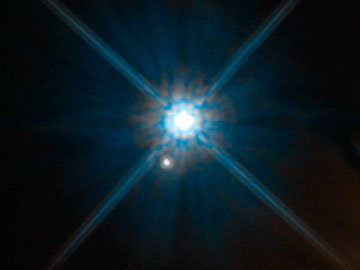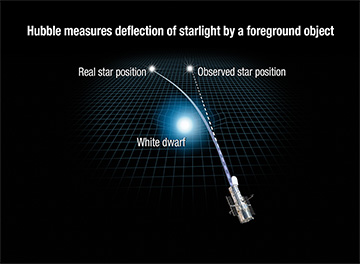
Astronomers used the superior angular resolution of the Hubble Space Telescope’s Wide Field Camera 3 to assess the gravitational bending of light from a background star (small object in picture), about 5,000 light years away, by the much closer and brighter white-dwarf star Stein 2051B (larger object), 17 light years away. [Image: NASA, ESA, and K. Sahu (STScI)]
With excitement continuing to build over the next year’s planned launch of the James Webb Space Telescope, it’s easy to forget that its predecessor—the Hubble Space Telescope (HST), originally put into Earth orbit more than 27 years ago—still has some great science left to do. The latest evidence: researchers have used the superior angular resolution of the HST’s Wide Field Camera 3 to directly determine, through the gravitational bending of light, the mass of a white-dwarf star 17 light years away (Science, doi: 10.1126/science.aal2879).
Stellar lenses and “Einstein rings”
What is now called “gravitational microlensing” was one of the most famous predictions of Einstein’s general theory of relativity. Under that theory of gravity, massive bodies such as stars actually deform the space around them; as a result, the theory predicts that the spatial warping could deflect light from distant stars around such a body. That prediction, made in 1915, was borne out four years later in a celebrated experiment by the British astronomer Arthur Eddington, who measured the deflection of a background star’s light by the sun’s gravity during a total solar eclipse.
In a 1936 gloss on his original theory in the journal Science, Einstein noted “the results of a little calculation which I had made” on the lens-like effects of stars. If two stars were lined up precisely, he suggested, the observer would in principle perceive, because of the bending of the light from the far star by the nearer one, a “luminius [sic] circle” of a predictable angular radius around the closer star—a phenomenon that came to be called an “Einstein ring.”
Einstein himself blithely noted that “of course, there is no hope of observing this phenomenon directly,” given that the chances of such alignment are remote in themselves, and because the angular deflection of light by a star outside of our solar system “will defy the resolving power of our instruments.” The most one could hope to observe, he wrote, would be an increase in the apparent brightness of the closer of the two stars.
Subtle signal
The gravity of a white dwarf star warps space and bends the light of a distant star behind it. [Image: NASA, ESA, and A. Feild (STScI)] [Enlarge image]
Some eighty years later, scientists did have an instrument with potentially sufficient resolving power, the HST. But they still needed to find a pair of stars with the right alignment at the right time.
To do so, researchers in the United States, Canada, and the United Kingdom—led by Kailash Sahu of the Space Telescope Science Institute (STScI) in Baltimore, Md., USA—computationally scoured a catalog of more than 5,000 nearby stars. They looked for candidates that had particularly rapid apparent motions in the sky, and that thus might have a better shot at lining up in the right way with a more distant star. They settled on the white-dwarf star called Stein 2051B, around 17 light years from earth. They then observed Stein 2051B (using the HST’s Wide Field Camera 3) seven times over the course of two years to assess its gravitational effect on light from a specific, much more distant background star around 5,000 light years away.
Even with the HST’s superior resolving power, that effect was tough to see; Stein 2015B appears about 400 times brighter to an Earth observer than the background star, and the lensing effect was expected to be around three orders of magnitude smaller than the one observed by Eddington during the 1919 eclipse. Nonetheless, the team did indeed manage to tease out the gravitational lensing of the distant star’s light by the closer one—the first measurement of such a deflection by a star other than the sun.
Weighing a star with light
The STScI-led team went further, however, using the angular deflection they observed from the light of the background star to get at the mass of the closer Stein 2015B. Under Einstein’s equations, the radius of an Einstein ring relates directly to the square root of the mass of the closer (lensing) object. While, even with the HST’s sensitive instruments, the research team did not directly observe an Einstein ring, they were able to infer the ring’s radius over the series of measurements through the slightly asymmetric apparent offsets of the distant star and their impacts on the closer star’s brightness.
As a result, the researchers were able to put the mass of Stein 2015B at 0.675±0.051 solar masses—right in line with the theoretical expectations for a white dwarf of its radius. That observation was interesting in itself, since Stein 2015B in particular has attracted some controversy, with suggestions that it might represent an exotic “iron-core” white dwarf with an anomalously large mass. The new observations suggest that the star actually lies right in the white-dwarf mainstream.
More broadly, the “astrometric lensing” technique that the new research lays out offers a nice additional arrow in the quiver of astronomers seeking to suss out stellar masses across the sky. And the catalog of stars open for such analysis could expand significantly in coming years as new instruments come online, conducting even more massive sky surveys. (The Large Synoptic Survey Telescope, for example, slated to go online in 2023, will undertake a 10-year sky-survey campaign that’s expected to produce a 200-petabyte data set.)
“This microlensing method is a very independent and direct way to determine the mass of a star,” team leader Sahu said in a press release. “It’s like placing the star on a scale.”

